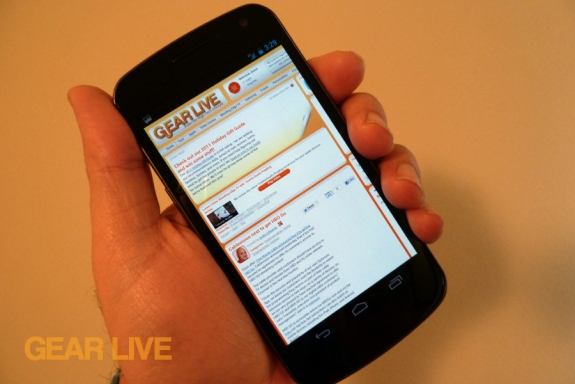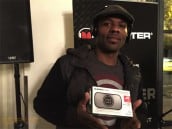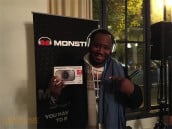Find Our Latest Video Reviews on YouTube!
If you want to stay on top of all of our video reviews of the latest tech, be sure to check out and subscribe to the Gear Live YouTube channel, hosted by Andru Edwards! It’s free!
Thursday December 22, 2011 11:33 am
Samsung Galaxy Nexus review

How much does Android 4.0 mean to you? How much do you need to have it right now? Because that's the dilemma with the Samsung Galaxy Nexus smartphone ($299-$649). Overall it's not quite as good a phone as the Motorola Droid RAZR ($299). But right now, it's the only phone running Ice Cream Sandwich (ICS), and that's the future.
In many ways, this is the ultimate early adopter phone. The phone itself isn't perfect; typically, Nexus phones aren't the best hardware on the market. But the software takes a major leap forward, with everything from a better Gmail experience to a faster browser and the ability to put folders on your home screens. Do you need that right now? Then yes, you need the Nexus. Why else might you want to jump on board the latest flagship Google device? Hit the link and follow us through our full Galaxy Nexus review for the answers.
Physical Design
The Galaxy Nexus is a well-built but not extraordinary Samsung phone—which is to say, it's a giant piece of relatively well-engineered plastic. There's none of the metal and glass accents you see on top-of-the-line Motorola or Apple phones.
It's huge, though. This is physically the biggest phone I've seen recently, measuring 5.3 by 2.7 by 0.4 with a sprawling 4.65-inch, 1,280-by-720 Super AMOLED screen. The display is too big for people with smaller thumbs to use one-handed, but the Droid RAZR—which is almost the same size—has the same problem. Folks with smaller hands should consider the iPhone 4S or, to stick with Android, the Motorola Droid Bionic ($199). It isn't that heavy at 5.13 ounces, but I felt like my thumb got a major workout dragging down the notification pane even compared with my own HTC Sensation ($199), which is a pretty big phone.

There's a 1-megapixel camera on the front, a 5-megapixel camera on the back, Power and Volume buttons on the sides, and a standard 3.5mm headset jack on the bottom panel. The Galaxy Nexus has a removable battery, but there's no memory card slot to add to the 28.13GB of internal memory. More importantly, especially for Mac users, no memory card means no Mass Storage mode, which means having to use an awkward separate file transfer app to upload and download files on Macs. (Windows PCs have no such problems.)
Voice and Battery Performance
The Galaxy Nexus isn't a great voice phone, and our unit had some bizarre problems reporting reception. Using the dBm signal strength numbers in the Android settings panel, the Nexus would generally show weaker reception than a Droid RAZR sitting right next to it. The phone also had serious trouble recovering from a dropped 4G signal; after falling to 3G, sometimes it would need a reboot to find 4G again. But in any condition with a decent 4G signal, I got faster speeds on Speedtest.net on the Nexus than on the RAZR. Clearly, there are some firmware issues to be worked out here.
Voice calls were disappointing: tinny, thready, and scratchy, with volume wobble in the earpiece and an extremely harsh tone on the other end. Just to check, I compared calls with a Droid RAZR in the same location, and the RAZR came through clearer and warmer. The speakerphone delivers moderate volume, and the phone does a good job cancelling background noise. The Nexus worked very well with our Jawbone Icon Bluetooth headset ($99, 4 stars) as well as with our Altec Lansing BackBeat stereo Bluetooth headphones ($99, 3.5 stars). Voice dialing was spot on.
The Galaxy Nexus connects to Verizon's 3G CDMA EVDO Rev A and 4G LTE networks, as well as to Wi-Fi 802.11 a/b/g/n and Bluetooth 3.0. I got excellent speeds on the 4G LTE network, consistently better than the Droid RAZR: Downloads ranged from 5.2Mbps up to a stunning 20.7Mbps, and uploads ranged from 4Mbps to 9.5Mbps. You can share your connection with up to 10 devices as a Wi-Fi hotspot, so it's great that ICS now includes an easy-to-read settings pane showing your moment-by-moment and app-by-app data usage.
The phone also supports NFC, but Verizon has declined to allow Google Wallet, so the functionality is pretty much useless for now.
The Nexus has decent but not excellent battery life, with 5 hours and 58 minutes of talk time in our tests. While that's fine, and the phone will probably last a day in normal use, the Droid RAZR lasted much longer with 8 hours and 42 minutes.
Gallery:
Performance and Apps
The Nexus is built around a dual-core TI OMAP4460 processor running at 1.2GHz. Performance on the overall Antutu system benchmark put the Galaxy Nexus safely in the top range of Android smartphones, although it's bested by the Droid RAZR on Verizon and Samsung's Galaxy S II Skyrocket ($299, 4.5 stars) on AT&T. Where the ICS advantage shows up is in browsing: The Galaxy Nexus killed every Gingerbread phone other than the Droid RAZR on the Browsermark browsing benchmark. That's because ICS incorporates dramatic browser improvements which began in Android 3.0, Honeycomb.
And, oh, what a better browser it is! I go into more detail in my Ice Cream Sandwich review, but the ICS browser is a major improvement from the Gingerbread browser. My favorite new options are the ability to easily disable mobile Web sites and switch to desktop versions, and the "read offline" button. Web pages look super-sharp on the 1,280-by-720 screen. Adobe Flash 11 plays smoothly, as well.
I didn't run into any app compatibility problems downloading a dozen or so apps from the Android Market, which is a better result than I saw just a few weeks ago. When there are tablet and phone versions of apps (such as with CNN and Pulse), the apps correctly formatted themselves for a phone; meanwhile, some Honeycomb-only apps like Dual Screen Browser (which puts two browser windows on your screen) ran well on the Nexus and didn't appear in the RAZR's market at all.
Take a look at our Ice Cream Sandwich review for more details on the new OS, but the general theme is smoother, richer, and better. Everything's been polished to a more attractive shine, and animations run more smoothly than on devices like the Droid RAZR. There's one major missing feature, though: Older phones have much better Facebook integration, including combining your Facebook contacts into your address book. That feature is sure to come in future ICS phones, though it may skip the Nexus.
Verizon couldn't help but to throw in some bloatware. You can't delete My Verizon Mobile or VZ Backup Assistant, although you can "disable" (and thus hide) the apps.
Multimedia
The quality of the 5-megapixel camera won't make or break your purchase. It's impressively fast, thanks to the new ICS camera app: Hit the button, and it takes a shot. But there's a little bit of smoke and mirrors here. The phone uses continuous autofocus. As long as you have it pointed at your subject for about a second before taking your shot, you'll be fine, but in that first second, it's possible to take a very blurry picture.
Images are adequate. Color balance is good, better than the Droid RAZR, which turned some of our test shots red and blue. Outdoors, you'll see some artifacts and blown-out bright areas. The iPhone 4S's pictures are much cleaner. Low light performance is good—the Nexus goes for noisy rather than blurry if it has to reduce image quality, and I prefer noise to blur.

Video recording runs at 24 frames per second in 1080p mode—not quite perfectly smooth—and at a smooth 30 frames per second for 720p. Videos are bright, a bit washed out, but once again, fine for a cameraphone. The 1-megapixel front camera does quite well in low light, and also records 720p videos at 28 frames per second.
Music and video playback at resolutions up to 1080p was fine, through both wired and Bluetooth headphones. I love Ice Cream Sandwich's new graphic equalizer, which can seriously boost your bass. The phone is missing a few of the typical video codecs, though—while H.264 video plays fine, DivX and Xvid won't.
HDMI output requires a slightly awkward MHL adapter, and it's buggy. The phone's video output bled slightly beyond the viewable area of our Samsung TV, losing the edges of images and looking a bit sloppy. The UI was smooth at 720p resolution and videos played at up to 1080p without a problem, save for those lost edges.
By the way, because several people have asked me, there is no FM radio.
Conclusions
It pains me to do this, but I'm not giving the Samsung Galaxy Nexus an Editor's Choice—even though I think Android phone buyers should seek out the Ice Cream Sandwich OS. The problem is that the Droid RAZR is just a better phone. Even though it has a lower screen resolution, it's better built, with better signal reception and voice quality; most other hardware features are a wash between the two phones. Motorola claims an ICS update for the RAZR is coming in the first half of 2012, and we're sure to see many more ICS phones in the next couple of months.
That said, many people will buy the Galaxy Nexus, and many people will like it. The core market is software developers and people who root and hack phones; they want the phone blessed by Google, even though it's been slightly cursed by Verizon bloatware.
Also, just to dodge the brickbats, I might as well mention the Apple iPhone 4S. The 4S has a better camera and is much, much more compact. There's something a little intimidating about these physically huge phones, and it isn't just Verizon's scare-your-cattle ad campaigns. While the 4S makes you give up 4G LTE—truly a major loss—it fits much better in a smaller hand, it has an elegant UI, and it has a terrific range of third-party apps.
This article, written by Sascha Segan, originally appeared on PCMag.com and is republished on Gear Live with the permission of Ziff Davis, Inc.
Latest Gear Live Videos
Advertisement
Advertisement
Advertisement
© Gear Live Inc. {year} – User-posted content, unless source is quoted, is licensed under a Creative Commons Public Domain License. Gear Live graphics, logos, designs, page headers, button icons, videos, articles, blogs, forums, scripts and other service names are the trademarks of Gear Live Inc.

















